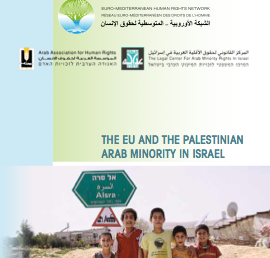Discrimination in land and housing against Palestinian citizens of Israel in 2015 (March 2016)
[CLICK HERE to read this briefing paper in PDF format]
I. Overview
In view of the housing crisis in the Palestinian Arab community in Israel, and on the occasion of the 40th anniversary of Land Day today, 30 March 2016, Adalah conducted an analysis of the land marketing policy and the tenders published by the Israel Land Authority (ILA) and the Israeli Ministry of Construction and Housing in 2015. The data reveals that the marketing of land by the ILA, along with efforts to lower housing prices, are predominantly being carried out in Israeli Jewish and mixed Arab-Jewish towns/neighborhoods, while almost no effort is being invested in solving the housing shortage in 136 Arab communities in which over 91% of the Arab population resides. An Annex is provided at the end of this paper listing the figures for tenders in 2015 throughout Israel and in the occupied West Bank, including East Jerusalem.
As Adalah emphasized in its report to the Israeli State Comptroller in April 2015, the housing shortage in Arab localities in Israel is not the result of specific failures or unintentional neglect on the part of state authorities. Rather, it is the product of a systematic and deliberate policy carried out by the state since 1948 that has viewed Palestinian citizens of Israel as enemies and aliens, while the state pursues its agenda to “Judaize” all parts of the country.
Since Israel’s establishment, the state’s policy has been characterized by the shrinking of the Arab population’s living space and their communities’ areas of jurisdiction; segregation in housing between Israeli Jews and Arabs; denial of the return of internally displaced Palestinians and Palestinian refugees to their lands and villages; non-recognition of dozens of Arab Bedouin villages in the Naqab (Negev); and large scale expropriation of most of the property belonging to Palestinian citizens of the state.
A proper and just solution to the housing crisis in Israel’s Palestinian communities therefore cannot be achieved without rectifying the ongoing historical wrongs mentioned above, and without contending with the overarching historical discrimination against the Palestinian minority in a deep and comprehensive manner.
Although the Israeli government established the “993 Days Team” in December 2014 to formulate a plan for resolving the housing problems in Arab localities, the team’s recommendations, even if fully implemented, will not suffice. Notably, even the team’s report maintained that the government’s programs for affordable housing – such as “Target Price”, “Occupant’s Price” and “Construction for Rental Housing” – are being implemented in Jewish communities and do not offer tangible solutions to the housing shortage in Arab localities.
The 120 Days Team’s report notes that 43% of all the marketing endeavors carried out in the wake of Government Decisions No. 1539 and 4432, the purpose of which included bolstering the housing market in Arab communities, have failed. The report also reveals that in the years 2005-2009, only 20% of the planned housing units in Arab communities (approx. 30,000) were actually marketed, in contrast with 70% of the planned housing units in Israeli Jewish and mixed Arab-Jewish communities (approximately 170,000).
Moreover, very few construction projects have started in Arab communities, and there is a shortage of detailed plans and state lands designated for development, all while housing prices are rising. For example, in 2011, the average price of apartments in the new neighborhoods of Nazareth (the largest Arab town in Israel) was equivalent to approximately 190 average monthly salaries, while the national average was equivalent to 145 salaries. The data further reveals that the Arab population in Israel requires 13,000 new housing units per year, yet in practice only 7,000 housing units are built, mostly by means of private, self-construction. The significance of this shortfall is that there is a shortage of 6,000 units every year, in addition to the shortage that has accumulated over decades, the scope of which has yet to be estimated.
The year 2015 was also characterized by the further deepening of the relationship between state authorities and organizations such as the Jewish National Fund (JNF) and the World Zionist Organization (WZO), making these inherently discriminatory organizations full partners in determining the state’s land policy and further violating the rights of Palestinian citizens of the state to equality and dignity. This trend was reflected in several developments including:
- The enactment of Amendment No. 2 to the World Zionist Organization – Jewish Agency (Status) Law 5713-1952, which grants the government the authority to delegate some of its powers in the field of settlement to the WZO (by means of its Settlement Division);
- The signing of an agreement that comprehensively regulates the relationship between the state and the JNF, and validates the agreement on principles concerning land exchange signed on 26 May 2009. According to the land swap agreement, the JNF would cede control of developed land in the center of the country, and in exchange, the ILA would give the JNF ownership of lands in the Naqab and in the Galilee. Whenever an Arab citizen wins a bid for land, the JNF would be “reimbursed” with alternative land.
- The annulment of the government order to reduce the number of JNF representatives on the Israel Land Council to two persons, thereby keeping the number of JNF representatives to 6 out of 13 members as stipulated in Article 4a(a) of the Israel Land Authority Law 5720 – 1960.
II. Analysis of ILA and Ministry of Construction tenders issued in 2015
Adalah’s analysis of the ILA tenders published in 2015 for the construction and marketing of housing units reveals that, as in previous years, only a negligible share of these bids were allocated to Arab communities. According to the data, in 2015 the ILA published tenders to market lands for the construction of 38,095 housing units in Jewish communities and mixed cities, as opposed to only 1,835 units in Arab localities (4.6% of the overall marketed units).
Moreover, in 2015 the ILA marketed 27,539 housing units in Israeli Jewish and mixed communities in the framework of the “Occupant’s Price” program for lowering housing prices, in contrast with 729 housing units marketed in Arab communities under this framework. These figures prove that even a program described by the Ministry of Construction and the Ministry of Finance as the “spearhead” of government efforts to advance housing solutions to the public in fact overlooks Israel’s Arab communities.
Explicit discrimination towards the Arab population in Israel is not limited to the absence of construction and marketing of housing units. It also exists in the scant allocation of land for industrial, commercial, tourist and other zones, which could advance the economic development of Arab communities. In 2015, the ILA published tenders for the establishment of 18 industrial zones in Israeli Jewish communities, but only two tenders in Arab communities. Furthermore during the same period, the ILA published 37 tenders for commercial and/or office zones in Israeli Jewish and mixed communities (11 of which are in West Bank settlements), compared to only five tenders in Arab communities in Israel.
III. National Priority Areas: Ongoing discrimination
Another aspect related to housing benefits is the designation of national priority areas (NPAs). Both the Ministry of Construction and Housing and the ILA grant housing benefits to communities in NPAs. The Ministry subsidizes development costs for new housing in these communities by 20%-70%, according to their classification category, and the ILA’s benefits are implemented through discounts relating to land leasing fees (in priority areas A, the lease holder pays 31% of the land value; in priority areas B, the lease holder pays 51 % of the value).
According to the Ministry’s data, there are only 30 Arab communities on the list of 558 rural localities classified as national priority areas, or only 5% of the total. Most of these Arab communities are entitled to the lowest level of aid. The discrimination is more evident when examining the communities that actually received the benefits in practice (and not merely listed as localities entitled to benefits). The data reveals that of the approximately 360 rural communities that actually received their benefits in practice from the Ministry, only 3 were Arab villages (or less than 1%).
Moreover, according to the ILA’s data, 122 Arab communities are included in the list of 456 communities classified as national priority areas (26.7%). This seemingly constitutes a high number of Arab communities, but like the Ministry of Construction and Housing’s list, the NPA classification does not guarantee the receipt of aid. Thus, in the absence of the marketing of land in Arab localities, the communities’ classification as NPAs is, in effect, immaterial.
IV. Construction in West Bank settlements & the sale of Palestinian refugee properties
The tenders issued in 2015 for developing Israeli Jewish settlements in the occupied West Bank including East Jerusalem demonstrate the State of Israel’s ongoing efforts to expand its settlements in violation of international law. The data compiled by Adalah reveals that in 2015, the ILA issued 14 tenders for the construction of 1,143 housing units in the settlements.
In addition, the ILA published 44 tenders throughout the country for the sale of properties belonging to Palestinian refugees (known as “Absentee properties”), despite the exceptional legal, historical and political status of these properties, and despite the fact that selling these properties also violates international law.
Annex: Analysis of the Israel Land Authority Tenders in 2015
Comparative Table 1:
No. of housing units marketed in Israeli Jewish/mixed communities vs. Arab communities
|
|
Israeli Jewish & mixed communities |
Arab communities (and percentage of overall rate) |
|
Marketed housing units |
38,095 |
1,835 (4.6%) |
|
Number of units marketed in the framework of the “Occupant’s Price” program |
27,539 |
729 (2.6%) |
Comparative Table 2:
No. of housing units marketed in West Bank settlements vs. Arab communities
|
|
Settlements in the OPT |
Arab communities |
|
Marketed housing units |
1,143 |
1,835 |
|
Residents |
Approximately 550,000 |
Approximately 1,200,000 |
Comparative Table 3:
No. of tenders published for industrial zones in Israeli Jewish/mixed vs. Arab communities
|
|
Israeli Jewish & mixed communities |
Arab communities |
|
2015 |
18 |
2 |
Comparative Table 4:
No. of tenders published for commercial zones in Israeli Jewish/mixed vs. Arab communities
|
|
Israeli Jewish (no. in settlements) & mixed communities |
Arab communities |
|
2015 |
37 (11) |
5 |
Table 5:
No. of Palestinian refugee properties (“Absentee properties”) sold in recent years
|
2015 |
2007 – 2015 |
|
44 |
Over 900 |
















